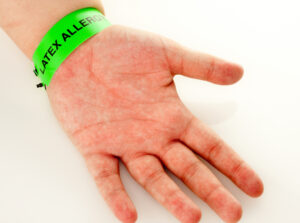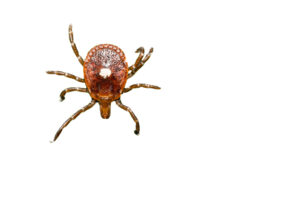
- XOLAIR (i.e., omalizumab) was the first biological approved by the FDA for the treatment of asthma. It was initially approved for adults in 2003 and later approved for children in 2006. Xolair acts by blocking the “allergy” antibody, commonly called IgE, which acts as a mediator of many disorders of immediate hypersensitivity. Xolair is used for adult and pediatric patients who are 6 years of age and older with moderate to severe persistent asthma, whose symptoms are inadequately controlled with inhaled corticosteroids, who have a positive allergy skin test or an in vitro (i.e., in the test tube) reactivity to a perennial aeroallergen such as dust mites. It is administered by subcutaneous (SQ) injections on a regular basis (i.e., every 4 weeks). The dose and frequency of administration depend on the IgE level and the weight of the patient. The IgE level is determined by a blood test. After getting the approval for the treatment of moderate to severe persistent asthma, Xolair subsequently was also approved for the treatment of chronic idiopathic urticaria (i.e., chronic hives) in patients ≥ 12 years of age who remain symptomatic despite H1 antihistamine (e.g., Clarinex, Claritin, Allegra, Zyrtec, Xyzal, Benadryl) treatment. Xolair has helped numerous individuals suffering from chronic hives. More recently, Xolair has received an additional indication for the add-on maintenance treatment of nasal polyps in adult patients ≥ 18 years of age who have an inadequate response to nasal corticosteroids (e.g., Flonase, Nasonex, Nasacort AQ, Rhinocort AQ, Qnasl) .
- NUCALA (i.e., mepolizumab) is a biological drug that blocks a cytokine called IL-5. It was approved in 2015 as an add-on maintenance treatment for patients with severe eosinophilic asthma aged 6 years and older. The approved recommended dosage is 100 mg once every 4 weeks given as a subcutaneous (SQ) injection. Later, Nucala also was approved for:
- Add-on maintenance treatment of chronic rhinosinusitis with nasal polyps (i.e., CRSwNP) in adult patients 18 years of age and older with an inadequate response to nasal corticosteroids
- Treatment of adult patients with eosinophilic granulomatosis with polyangiitis (i.e., EGPA)
- Treatment of adult and pediatric patients aged 12 years and older with hypereosinophilic syndrome (i.e., HES)
- FASENRA (i.e., benralizumab) is indicated for the add-on maintenance treatment in patients with severe eosinophilic asthma aged 12 years and older. It acts by rapidly depleting eosinophils which cause tissue damage when excessively activated and accumulated. The maintenance dose is 30 mg. injected subcutaneously (SQ) under the skin every 8 weeks.
- DUPIXENT (i.e., dupilumab) acts by blocking 2 pro-inflammatory cytokines called IL-4 and IL-13. It is administered every 2 weeks as a subcutaneous (SQ) injection under the skin.
It is used to treat:
- Adults and children 6 months of age and older with moderate to severe eczema (i.e., atopic dermatitis) that is not well controlled with prescription therapies used on the skin (i.e., topical), or who cannot use topical therapies
- With other asthma medications for the maintenance treatment of moderate to severe eosinophilic or oral steroid-dependent asthma in adults and children 6 years of age and older whose asthma is not controlled with their current asthma medications
- With other medications for the maintenance treatment of chronic rhinosinusitis with nasal polyposis (CRSwNP) in adults whose disease is not controlled
- Adults and children 12 years of age and older, who weigh at least 88 pounds (i.e., 40 kg), with eosinophilic esophagitis (EoE)
- Adults with prurigo nodularis (PN)
- TEZSPIRE (i.e., tezepelumab) is the most recent biological medication that was approved by the FDA for treatment of asthma. It is a medication that blocks the cytokine TSLP, a cytokine which plays a prominent role at the top of the inflammatory pathway. It is indicated for the add-on maintenance treatment of adult and pediatric patients aged 12 years and older with severe asthma. Tezspire can be used without checking for any biomarker levels such as IgE. It can also be used in most phenotypes of asthma and is not restricted to only be used in eosinophilic asthma as with some other biologicals. It is administered as an injection subcutaneously (SQ) under the skin in a single dose of 210 mg. every 4 weeks.
The board certified allergy doctors at Black & Kletz Allergy see both adult and pediatric patients and have over 50 decades of experience in the field of allergy, asthma, and immunology. Black & Kletz Allergy has 3 convenient locations with on-site parking located in Washington, DC, McLean, VA (Tysons Corner, VA), and Manassas, VA. The Washington, DC and McLean, VA offices are Metro accessible and we offer a free shuttle that runs between the McLean, VA office and the Spring Hill metro station on the silver line. To schedule an appointment, please call any of our offices or you may click Request an Appointment and we will respond within 24 hours by the next business day. We have been servicing the greater Washington, DC metropolitan area for over 50 years and we look forward to providing you with the highest state-of-the-art allergy care in a friendly and approachable environment.


 Now that it is turning cold in the
Now that it is turning cold in the  Egg allergy is second only to milk allergy in prevalence among infants and young children. It affects about 1 to 2 % of young children overall. It is also the most common food allergy in children with eczema.
Egg allergy is second only to milk allergy in prevalence among infants and young children. It affects about 1 to 2 % of young children overall. It is also the most common food allergy in children with eczema. Natural rubber latex is the milky white sap that comes from the Brazilian rubber tree. The Brazilian rubber tree is scientifically referred to as Hevea brasiliensis. The tree is mainly found in Southeast Asia and Africa. The sap is collected from rubber trees much in the same manner that maple syrup is extracted from maple trees. In order to give latex its elastic characteristic, several chemicals are added to the milky sap during the manufacturing process. The latex is then further refined into rubber for commercial use. This natural rubber should not be confused with synthetic rubber which is made from chemicals. Synthetic rubber products are not made with natural rubber latex and do not cause allergic reactions in individuals who are allergic to natural rubber latex.
Natural rubber latex is the milky white sap that comes from the Brazilian rubber tree. The Brazilian rubber tree is scientifically referred to as Hevea brasiliensis. The tree is mainly found in Southeast Asia and Africa. The sap is collected from rubber trees much in the same manner that maple syrup is extracted from maple trees. In order to give latex its elastic characteristic, several chemicals are added to the milky sap during the manufacturing process. The latex is then further refined into rubber for commercial use. This natural rubber should not be confused with synthetic rubber which is made from chemicals. Synthetic rubber products are not made with natural rubber latex and do not cause allergic reactions in individuals who are allergic to natural rubber latex.


 The mechanism of why and how the syndrome occurs is quite interesting. Alpha-gal, technically referred to as galactose-alpha-1,3-galactose, is a carbohydrate (i.e., sugar molecule) that is present in most mammals (e.g., cows, pigs, sheep, deer, rabbits, whales). It is not found in humans or non-mammals such as fish, birds, and reptiles. Alpha-gal syndrome is caused by a Lone Star tick bite. After an individual is bitten by a Lone Star tick, the carbohydrate alpha-gal which is present in the tick’s saliva, is transmitted into the person’s blood stream. As a result, the individual will produce IgE antibodies as a defense mechanism against this foreign sugar molecule (i.e., carbohydrate). Because the person now has alpha-gal IgE antibodies present in their blood stream, whenever that individual consumes future mammalian meat which contains alpha-gal, their alpha-gal IgE antibodies will react against the alpha-gal present in the mammalian meat (e.g., beef, pork, lamb, venison, rabbit, whale) causing allergic symptoms.
The mechanism of why and how the syndrome occurs is quite interesting. Alpha-gal, technically referred to as galactose-alpha-1,3-galactose, is a carbohydrate (i.e., sugar molecule) that is present in most mammals (e.g., cows, pigs, sheep, deer, rabbits, whales). It is not found in humans or non-mammals such as fish, birds, and reptiles. Alpha-gal syndrome is caused by a Lone Star tick bite. After an individual is bitten by a Lone Star tick, the carbohydrate alpha-gal which is present in the tick’s saliva, is transmitted into the person’s blood stream. As a result, the individual will produce IgE antibodies as a defense mechanism against this foreign sugar molecule (i.e., carbohydrate). Because the person now has alpha-gal IgE antibodies present in their blood stream, whenever that individual consumes future mammalian meat which contains alpha-gal, their alpha-gal IgE antibodies will react against the alpha-gal present in the mammalian meat (e.g., beef, pork, lamb, venison, rabbit, whale) causing allergic symptoms. Though there are still some unresolved controversies, the preponderance of evidence indicates that our climate is steadily changing over the past several decades and is likely to continue into near future. This climate change also has the potential to alter the incidence and severity of allergic and respiratory diseases in humans. Although each individual is different, a general trend towards more allergens and more severe allergic disease seems likely if climate change continues in the direction it is going. While it is already known that the prevalence of both allergic rhinitis (i.e., hay fever) and asthma have increased in the last few decades, it seems likely that these numbers will continue to increase in the near future, at least partially as a result of climate change.
Though there are still some unresolved controversies, the preponderance of evidence indicates that our climate is steadily changing over the past several decades and is likely to continue into near future. This climate change also has the potential to alter the incidence and severity of allergic and respiratory diseases in humans. Although each individual is different, a general trend towards more allergens and more severe allergic disease seems likely if climate change continues in the direction it is going. While it is already known that the prevalence of both allergic rhinitis (i.e., hay fever) and asthma have increased in the last few decades, it seems likely that these numbers will continue to increase in the near future, at least partially as a result of climate change.
 We love our pets. Pets are very important to humans. They fulfill all types of psychological and social needs that people desire including happiness, self-worth, and companionship. Unfortunately, some individuals cannot experience the joy of owning a pet because they have allergy or
We love our pets. Pets are very important to humans. They fulfill all types of psychological and social needs that people desire including happiness, self-worth, and companionship. Unfortunately, some individuals cannot experience the joy of owning a pet because they have allergy or 
 Is it possible to be allergic to exercise? Well, not really, however, exercise can cause the body to exhibit the signs and symptoms of allergies! We are also not talking about an excuse not to exercise! The mechanism by which exercise causes “allergy” symptoms is not completely understood but it seems to be related to an exaggerated cholinergic response to the warming that occurs with exercise and not due to an allergy at all. There is an increased level of histamine during and or following exercise in many of the conditions associated with this phenomenon. The severity of the “allergic” symptoms can range from mild to severe and in some cases they may be life-threatening. As a general rule, patients should stop exercising at the first sign of an “allergic” or asthmatic reaction. It may be recommended by a board certified allergist that individuals with any of the following conditions carry an epinephrine self-injectable device (i.e., EpiPen,Auvi-Q, Adrenaclick). It should also be noted that if one uses such as device, he or she should go immediately to the closest emergency room. Below are some examples of conditions where exercise causes symptoms that mimic allergies:
Is it possible to be allergic to exercise? Well, not really, however, exercise can cause the body to exhibit the signs and symptoms of allergies! We are also not talking about an excuse not to exercise! The mechanism by which exercise causes “allergy” symptoms is not completely understood but it seems to be related to an exaggerated cholinergic response to the warming that occurs with exercise and not due to an allergy at all. There is an increased level of histamine during and or following exercise in many of the conditions associated with this phenomenon. The severity of the “allergic” symptoms can range from mild to severe and in some cases they may be life-threatening. As a general rule, patients should stop exercising at the first sign of an “allergic” or asthmatic reaction. It may be recommended by a board certified allergist that individuals with any of the following conditions carry an epinephrine self-injectable device (i.e., EpiPen,Auvi-Q, Adrenaclick). It should also be noted that if one uses such as device, he or she should go immediately to the closest emergency room. Below are some examples of conditions where exercise causes symptoms that mimic allergies: The esophagus is a tubal structure that propels food from the throat into the stomach through rhythmic contractions of the smooth muscles in its walls. A thin mucus membrane lines the insides of its lumen. Eosinophils are type of white blood cells that have some role in combating certain parasitic infections. Eosinophils can also cause damage to tissues when they are accumulated in excess, due to a chronic inflammatory process.
The esophagus is a tubal structure that propels food from the throat into the stomach through rhythmic contractions of the smooth muscles in its walls. A thin mucus membrane lines the insides of its lumen. Eosinophils are type of white blood cells that have some role in combating certain parasitic infections. Eosinophils can also cause damage to tissues when they are accumulated in excess, due to a chronic inflammatory process. Generalized pruritus (i.e., generalized itching) is not an uncommon condition and can be quite maddening to the individual suffering from it. It may be associated with
Generalized pruritus (i.e., generalized itching) is not an uncommon condition and can be quite maddening to the individual suffering from it. It may be associated with  There are disease states where medications taken by mouth do not offer enough benefit in either relieving symptoms, stopping the progression of a condition, or preventing complications of a disease. In these instances, medications may need to be administered by means of the parenteral route, such as using a needle or catheter to infuse the medication.
There are disease states where medications taken by mouth do not offer enough benefit in either relieving symptoms, stopping the progression of a condition, or preventing complications of a disease. In these instances, medications may need to be administered by means of the parenteral route, such as using a needle or catheter to infuse the medication.









